Performance of Generator Translation and Rotation on Stroke Length Drive of the Two-Rod Mechanism in Renewable Energy Power Plant
Abstract
1. Introduction
2. Materials and Methods
2.1. Materials and Equipment
2.2. Experimental Method
- Ns = rotation of generator (rpm);
- f = frequency of generator (Hz);
- p = number of magnetic poles.
2.3. Set Up and Testing of Generator Translation and Rotational Motion
- P = power of generator (rpm);
- V = voltage of generator (V);
- I = electric current (A).
3. Results
3.1. Results of Performance Generator Translational and Rotational Motions with Stroke Length 170 mm, 230 mm, and 270 mm
| Performance of Generator | |||||
|---|---|---|---|---|---|
| Rotation of Generator Translational Motion (Rpm) | Rotation of Generator Rotational Motion (Rpm) | Voltage of Generator Translational Motion (V) | Frequency of Generator Translational Motion (Hz) | Voltage of Generator Rotational Motion (V) | Frequency of Generator Rotational Motion (Hz) |
| 102 | 510 | 30.9 | 6.8 | 0.5 | 34.0 |
| 118 | 600 | 31.9 | 7.9 | 0.3 | 40.0 |
| 180 | 900 | 34.8 | 12.0 | 0.9 | 60.0 |
| 191 | 955 | 35.8 | 12.7 | 0.5 | 63.7 |
| Performance of Generator | |||||
|---|---|---|---|---|---|
| Rotation of Generator Translational Motion (Rpm) | Rotation of Generator Rotational Motion (Rpm) | Voltage of Generator Translational Motion (V) | Frequency of Generator Translational Motion (Hz) | Voltage of Generator Rotational Motion (V) | Frequency of Generator Translational Motion (Hz) |
| 78 | 390 | 46.7 | 5.2 | 0.5 | 19.5 |
| 82 | 407 | 47.6 | 5.5 | 0.4 | 20.3 |
| 168 | 840 | 48.9 | 11.2 | 0.5 | 42.0 |
| 172 | 860 | 55.5 | 11.5 | 0.5 | 43.0 |
| Performance of Generator | |||||
|---|---|---|---|---|---|
| Rotation of Generator Translational Motion (Rpm) | Rotation of Generator Rotational Motion (Rpm) | Voltage of Generator Translational Motion (V) | Frequency of Generator Translational Motion (Hz) | Voltage of Generator Rotational Motion (V) | Frequency of Generator Translational Motion (Hz) |
| 172 | 860 | 55.5 | 11.5 | 0.5 | 43.0 |
| 209.2 | 922.2 | 39.9 | 13.9 | 0.03 | 46.1 |
| 241.9 | 739.9 | 41.8 | 16.1 | 0.04 | 37.0 |
| 256.5 | 739.9 | 40.7 | 17.1 | 0.02 | 37.0 |
3.2. Results of Performance Generator Translation and Rotation with Load LED Lamp
| Performance of Generator | ||||
|---|---|---|---|---|
| Rotation of Generator Translational Motion | Rotation of Generator Rotational Motion | Voltage of Generator Translational and Rotational Motion (V) | Current of Generator Translational and Rotational Motion (mA) | Power of Generator Translational and Rotational Motion (w) |
| (Rpm) | (Rpm) | |||
| 200.1 | 1000 | 29 | 1.3 | 0.377 |
| 217.6 | 1088 | 35.5 | 1 | 0.355 |
| 220 | 1100 | 36.9 | 0.9 | 0.332 |
| 235.6 | 1178 | 37.7 | 0.4 | 0.151 |
3.3. Results of Performance Generator Translation and Rotation in Series
| Performance of Generator | |
|---|---|
| Rotation of Generator Translational and Rotational Motion (Rpm) | Voltage of Generator Translational and Rotational Motion (V) |
| 179.2 | 57.4 |
| 202.5 | 62 |
| 203.3 | 63.3 |
| 205.3 | 65.3 |
| 209 | 71.9 |
| 241 | 77.5 |
| 242.3 | 79.5 |
3.4. Results of Performance Generator Translation and Rotation in Parallel
| Performance of Generator | |
|---|---|
| Rotation of Generator Translational and Rotational Motion (Rpm) | Voltage of Generator Translational and Rotational Motion (V) |
| 194.7 | 36.6 |
| 207.5 | 36.4 |
| 213.2 | 36.1 |
| 222.9 | 43.9 |
| 246.2 | 44.7 |
4. Discussion
5. Conclusions
Author Contributions
Funding
Institutional Review Board Statement
Data Availability Statement
Conflicts of Interest
References
- Bundschuh, J.; Kaczmarczyk, M.; Ghaffour, N.; Tomaszewska, B. State-of-the-art of renewable energy sources used in water desalination: Present and future prospects. Desalination 2021, 508, 115035. [Google Scholar] [CrossRef]
- Hameed, S.S.; Ramadoss, R.; Raju, K.; Shafiullah, G. A Framework-Based Wind Forecasting to Assess Wind Potential with Improved Grey Wolf Optimization and Support Vector Regression. Sustainability 2022, 14, 4235. [Google Scholar] [CrossRef]
- Mito, M.T.; Ma, X.; Albuflasa, H.; Davies, P.A. Variable operation of a renewable energy-driven reverse osmosis system using model predictive control and variable recovery: Towards large-scale implementation. Desalination 2022, 532, 115715. [Google Scholar] [CrossRef]
- Li, Y.; Liu, Y.; Bai, W.; Li, B.; Xu, L. A Data-based Water-inflow Forecasting Method for Small/medium Sized Hydropower Plants in Spot Market. In Proceedings of the 2021 IEEE Sustainable Power and Energy Conference (iSPEC), Nanjing, China, 23–25 December 2021; pp. 3675–3679. [Google Scholar]
- Liszka, D.; Krzemianowski, Z.; Węgiel, T.; Borkowski, D.; Polniak, A.; Wawrzykowski, K.; Cebula, A. Alternative Solutions for Small Hydropower Plants. Energies 2022, 15, 1275. [Google Scholar] [CrossRef]
- Wu, C.; Zhang, X.-P.; Sterling, M. Wind power generation variations and aggregations. CSEE J. Power Energy Syst. 2022, 8, 17–38. [Google Scholar]
- Khan, M.A.M.; Rehman, S.; Al-Sulaiman, F.A. A hybrid renewable energy system as a potential energy source for water desalination using reverse osmosis: A review. Renew. Sustain. Energy Rev. 2018, 97, 456–477. [Google Scholar] [CrossRef]
- Krishnamoorthy, R.; Udhayakumar, K.; Kannadasan, R.; Madurai Elavarasan, R.; Mihet-Popa, L. An Assessment of Onshore and Offshore Wind Energy Potential in India Using Moth Flame Optimization. Energies 2020, 13, 3063. [Google Scholar]
- Tumiran; Putranto, L.M.; Wijaya, F.D.; Priyanto, A.; Savitri, I. Generation Expansion Planning Based on Local Renewable Energy Resources: A Case Study of the Isolated Ambon-Seram Power System. Sustainability 2022, 14, 3032. [Google Scholar] [CrossRef]
- Feilat, E.A.; Azzam, S.; Al-Salaymeh, A. Impact of large PV and wind power plants on voltage and frequency stability of Jordan’s national grid. Sustain. Cities Soc. 2018, 36, 257–271. [Google Scholar] [CrossRef]
- Mito, M.T.; Ma, X.; Albuflasa, H.; Davies, P.A. Reverse osmosis (RO) membrane desalination driven by wind and solar photovoltaic (PV) energy: State of the art and challenges for large-scale implementation. Renew. Sustain. Energy Rev. 2019, 112, 669–685. [Google Scholar] [CrossRef]
- Karekezi, S.; Lata, K.; Teixeira Coelho, S. Traditional Biomass Energy: Imporiving its Use and Moving to Modern Energy Use. Int. Conf. Renew. Energ. 2004, 53, 1689–1699. [Google Scholar]
- Tumiran; Na’Iem, M.; Sarjiya; Putranto, L.M.; Listyanto, T.; Priyanto, A.; Muthahhari, A.A.; Budi, R.F.S. Potential of Biomass as RE Source for Sustainable Electricity Supply in Eastern Indonesia. In Proceedings of the 2021 3rd International Conference on High Voltage Engineering and Power Systems (ICHVEPS), Bandung, Indonesia, 5–6 October 2021; IEEE: Piscataway, NJ, USA, 2021; pp. 22–27. [Google Scholar]
- Falcão, A.F.D.O. Wave energy utilization: A review of the technologies. Renew. Sustain. Energy Rev. 2010, 14, 899–918. [Google Scholar] [CrossRef]
- Rodrigues, L. Wave Power Conversion Systems for Electrical Energy Production; Department of Electrical Engineering, Faculty of Sciences and Technology, Nova University Lisbon: Caparica, Portugal, 2007. [Google Scholar]
- Anand, S. Turbines for Wave Energy Plants. In Proceedings of 8th International Symposium on Experimental and Computational Aerothermodynamics of Internal Flows, Lyon, France, 2–5 July 2007. [Google Scholar]
- Amundarain, M.; Alberdi, M.; Garrido, J.; Garido, I. Modeling and Simulation of Wave Energy Generation Plants: Output Power Control. IEEE Trans. Ind. Electron. 2011, 58, 105–117. [Google Scholar] [CrossRef]
- Casman, D.P.; Sullivan, D.L.; Egan, M.M.; Hayes, J.G. Modeling and Analysis of an Offshore Oscillating Water Column Wave Energy Converter. In Proceedings of the 8th European Wave and Tidal Energy Conference, Uppsala, Sweden, 7–10 September 2009; pp. 924–933. [Google Scholar]
- Neelamani, S. Wave Interaction with Floating Wave Energy Caisson Breakwaters. J. Coast. Res. 2006, II, 745–749. [Google Scholar]
- Farrok, O.; Ahmed, K.; Tahlil, A.D.; Farah, M.M.; Kiran, M.R.; Islam, M.R. Electrical Power Generation from the Oceanic Wave for Sustainable Advancement in Renewable Energy Technologies. Sustainability 2020, 12, 2178. [Google Scholar] [CrossRef]
- Farrok, O.; Islam, M.R.; Sheikh, M.R.I.; Guo, Y.G.; Zhu, J.G. Design and Analysis of a Novel Lightweight Translator Permanent Magnet Linear Generator for Oceanic Wave Energy Conversion. IEEE Trans. Magn. 2017, 53, 1–4. [Google Scholar] [CrossRef]
- Farrok, O.; Islam, M.R.; Islam Sheikh, M.R.; Guo, Y.; Zhu, J.; Lei, G. Oceanic Wave Energy Conversion by a Novel Permanent Magnet Linear Generator Capable of Preventing Demagnetization. IEEE Trans. Ind. Appl. 2018, 54, 6005–6014. [Google Scholar] [CrossRef]
- Molla, S.; Farrok, O.; Islam, M.R.; Muttaqi, K.M. Analysis and design of a high performance linear generator with high grade magnetic cores and high temperature superconducting coils for oceanic wave energy conversion. IEEE Trans. Appl. Supercond. 2019, 29, 5201105. [Google Scholar] [CrossRef]
- Pelc, R.; Fujita, R.M. Renewable energy from the ocean. Mar. Policy 2002, 26, 471–479. [Google Scholar] [CrossRef]
- Prudell, J.; Stoddard, M.; Amon, E.; Brekken, T.K.A.; von Jouanne, A. A permanent-magnet tubular linear generator for ocean wave energy conversion. IEEE Trans. Ind. Appl. 2010, 46, 2392–2400. [Google Scholar] [CrossRef]
- De la Villa-Ja’en, A.; García Santana, A.; Montoya, D. Maximizing output power of linear generator for wave energy conversion. Int. Trans. Electr. Energy Syst. 2014, 24, 875–890. [Google Scholar] [CrossRef]
- Indriani, A.; Hendra; Suhartini, Y.; Tanjung, A. Performance of Generator Pneumatic for Power Plant of Ocean Wave. IOP Conf. Ser. Mater. Sci. Eng. 2019, 505, 012120. [Google Scholar] [CrossRef]
- Indriani, A.; Suhartini, Y.; Hendra; Hernadewita; Rispandi. Performance of Generator Translation and Rotation Motion on Vertical Direction for Sea Wave Power Plant. IOP Conf. Ser. Mater. Sci. Eng. 2020, 1007, 012044. [Google Scholar] [CrossRef]
- Hendra; Indriani, A.; Hernadewita. Applying of Piston Mechanism Design Used in the Wavelength Electrical Generating of Ocean for Fishing Communities. Adv. Mater. Res. 2014, 918, 73–78. [Google Scholar] [CrossRef]
- Indriani, A.; Darmana, I.; Anon, H.; Setyawan, A.; Anon, H. Control output of generator translation and rotation using buck-boost converter for sea wave power plant. Int. J. Mech. Eng. Technol. IJMET 2020, 11, 61–74. [Google Scholar] [CrossRef]
- Indriani, A.; Hendra; Yenni, S.; Aswata, W.; Rispandi; Hernadewita; Tanjung, A. Stress analysis on the frame holder of generator translation motion on horizontal direction for sea wave power plant using finite element method (fem). IOP Conf. Ser. Mater. Sci. Eng. 2020, 909, 012033. [Google Scholar] [CrossRef]
- Suhartini, Y.; Indriani, A.; Hendra; Rispandi; Hernadewita. Finite element method for stress analysis in the frame holder of generator translation and rotation motion on vertical direction mechanism for sea wave power plant. IOP Conf. Ser. Mater. Sci. Eng. 2021, 1034, 012008. [Google Scholar] [CrossRef]
- Indriani, A.; Dimas, S.; Hendra. Effect of Dimension and Shape of Magnet on the Performance AC Generator with Translation Motion. IOP Conf. Ser. Mater. Sci. Eng. 2018, 307, 012020. [Google Scholar] [CrossRef]
- Wikipedia, Induction Motor. Available online: https://en.wikipedia.org/wiki/Induction_motor#cite_note-MDEMRC-33 (accessed on 8 February 2023).
- Induction Motors, Electricmotors.machinesdesign.com, Penton Media, Inc. 2022. Available online: http://www.electricmotors.machinedesign.com/guiEdits/Content/bdeee11/bdeee11_7.aspx (accessed on 8 February 2023).
- Wayne, B.H. Handbook of Electric Power Calculations; The McGraw-Hill Companies, Inc.: New York, NY, USA, 2001; ISBN 0-07-136298-3. [Google Scholar]
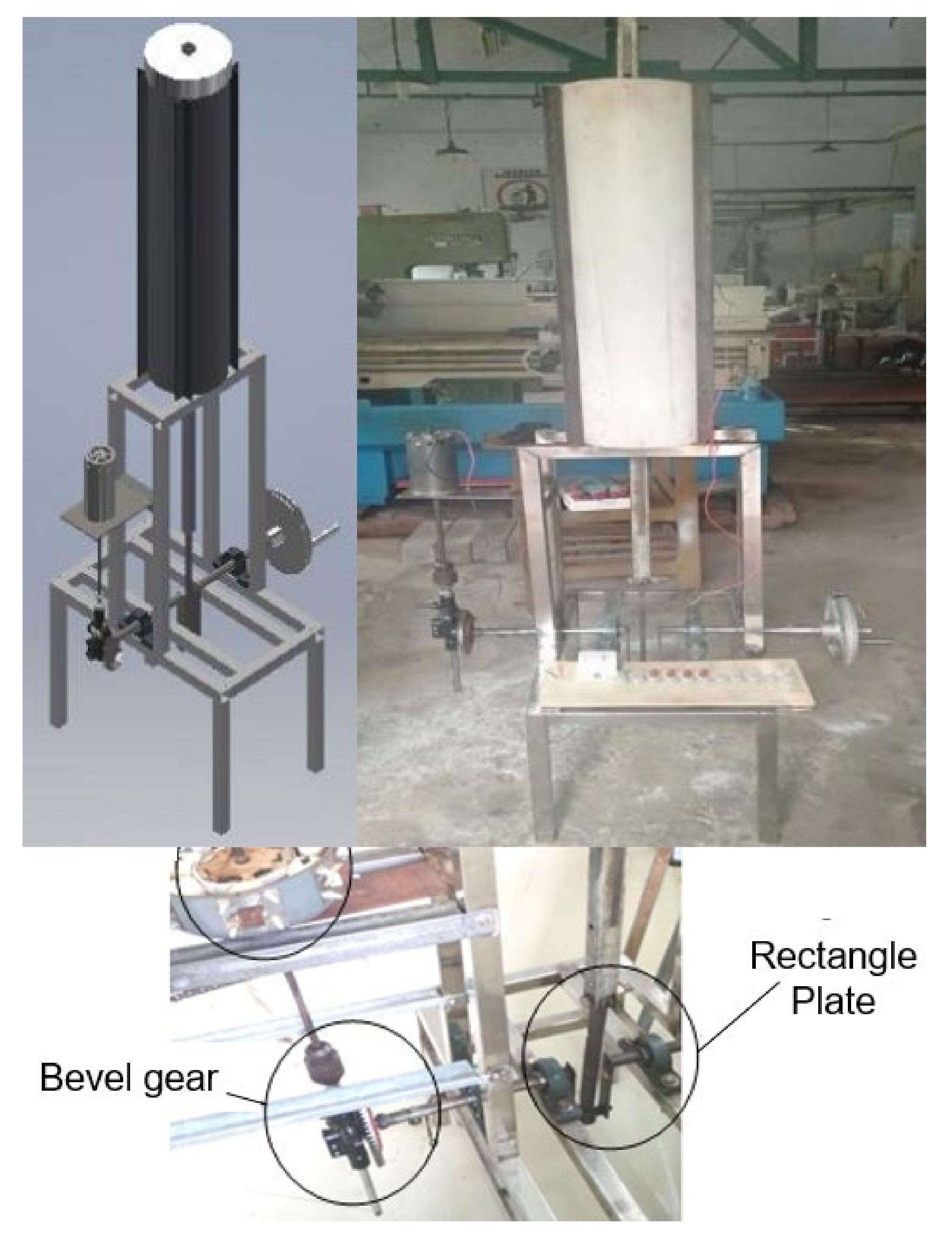
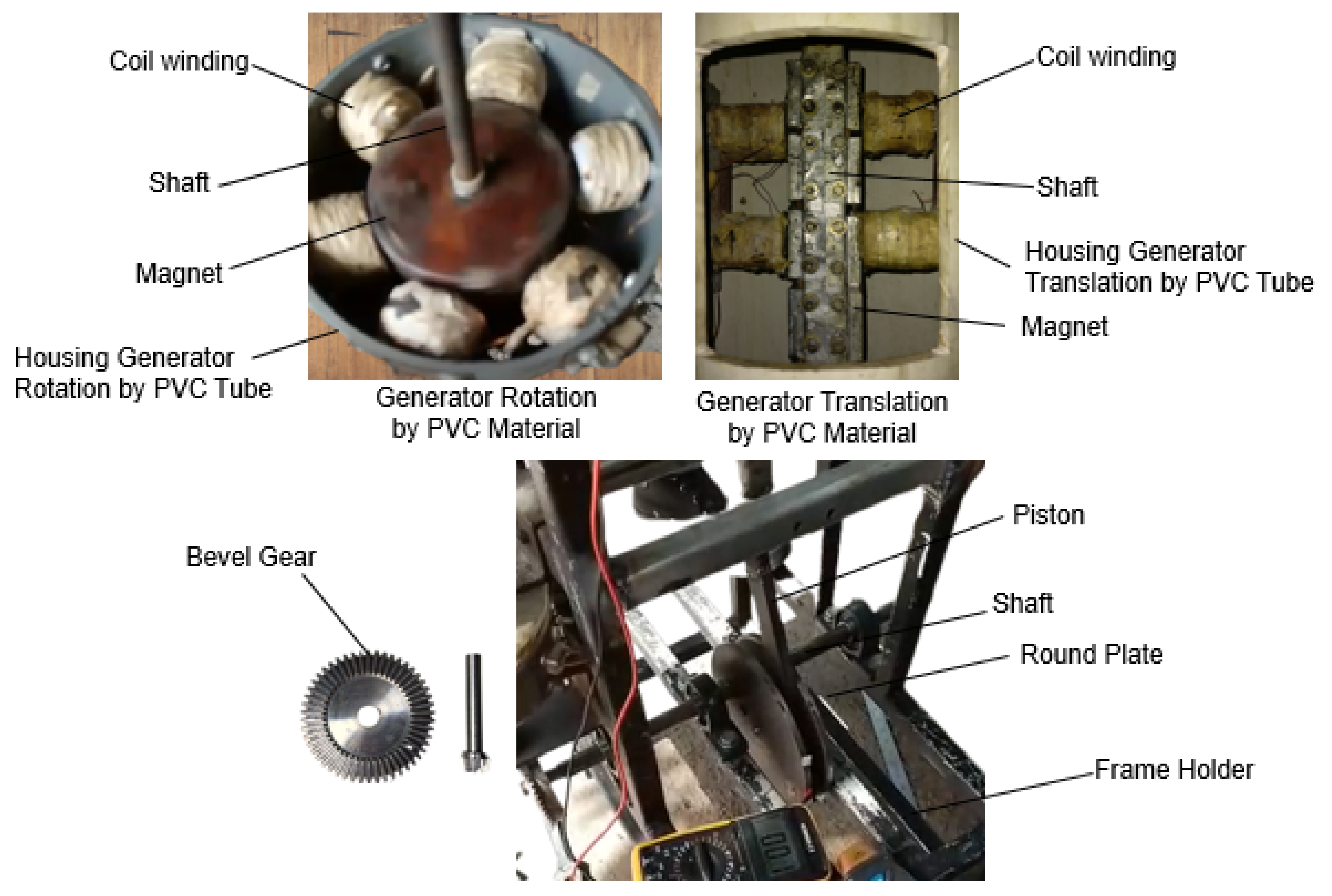

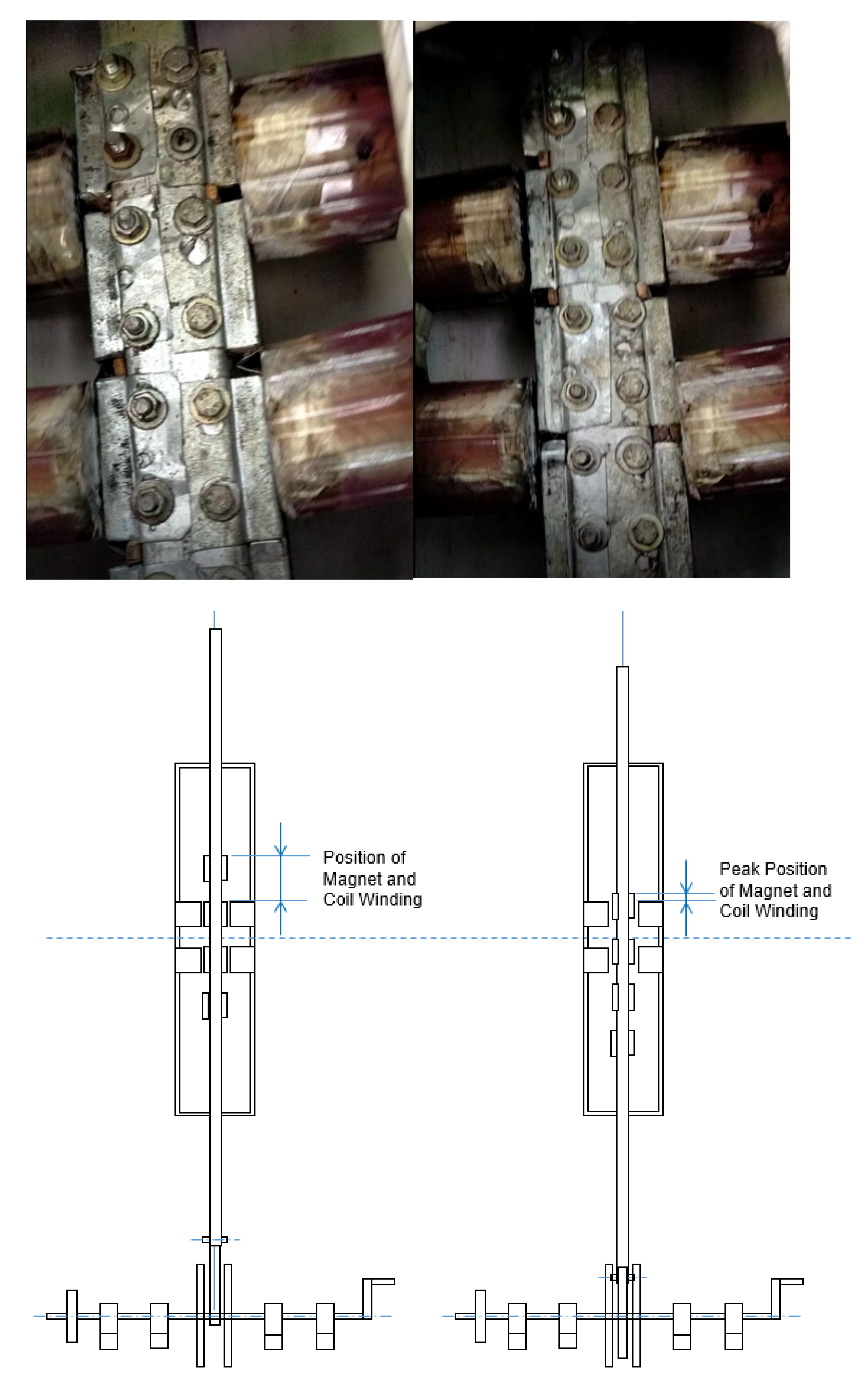
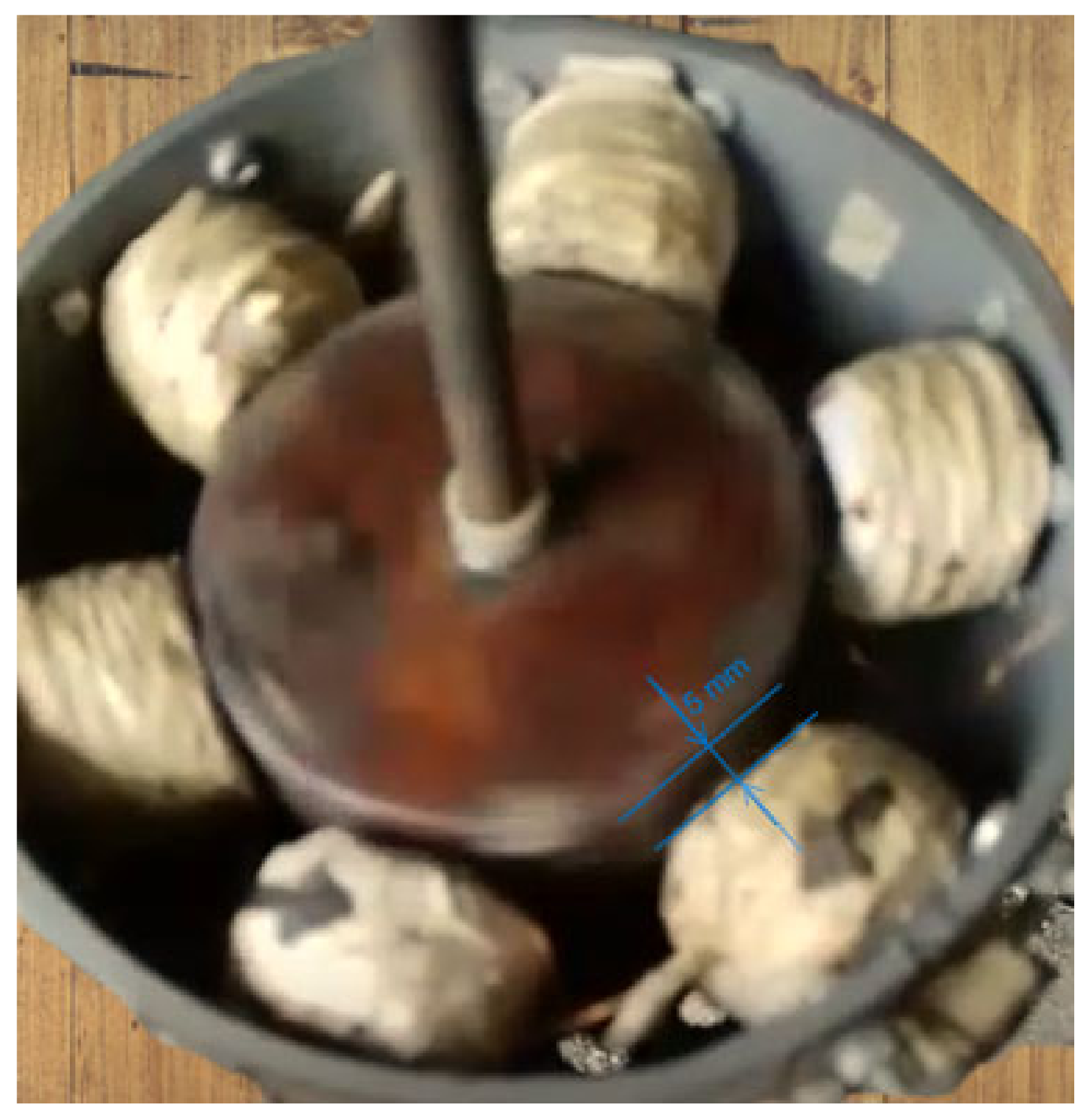
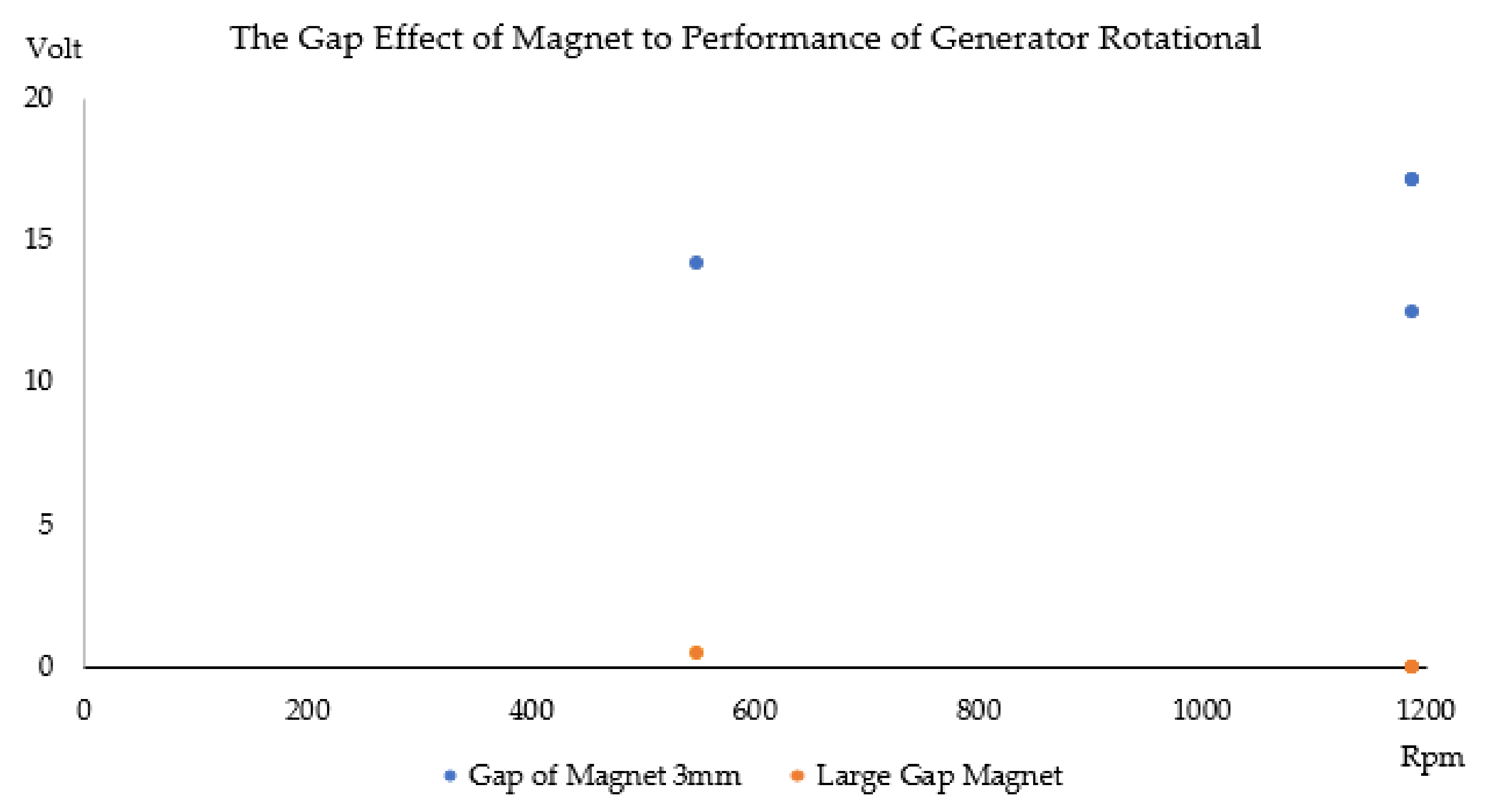
| Performance of Generator | |||
|---|---|---|---|
| Rotation of Generator Translational Motion (Rpm) | Rotation of Generator Rotational Motion (Rpm) | Voltage of Generator Translational Motion (V) | Voltage of Generator Rotational Motion (V) |
| 122.8 | 547.7 | 22.4 | 14.2 |
| 208 | 1188 | 22.2 | 12.5 |
| 240.6 | 1188 | 22.5 | 17.1 |
| 250 | 1188 | 23.9 | 17.1 |
Disclaimer/Publisher’s Note: The statements, opinions and data contained in all publications are solely those of the individual author(s) and contributor(s) and not of MDPI and/or the editor(s). MDPI and/or the editor(s) disclaim responsibility for any injury to people or property resulting from any ideas, methods, instructions or products referred to in the content. |
© 2023 by the authors. Licensee MDPI, Basel, Switzerland. This article is an open access article distributed under the terms and conditions of the Creative Commons Attribution (CC BY) license (https://creativecommons.org/licenses/by/4.0/).
Share and Cite
Hendra, H.; Satria, D.; Hernadewita, H.; Yozerizal, Y.; Hardian, F.; Galal, A.M. Performance of Generator Translation and Rotation on Stroke Length Drive of the Two-Rod Mechanism in Renewable Energy Power Plant. Sustainability 2023, 15, 5663. https://doi.org/10.3390/su15075663
Hendra H, Satria D, Hernadewita H, Yozerizal Y, Hardian F, Galal AM. Performance of Generator Translation and Rotation on Stroke Length Drive of the Two-Rod Mechanism in Renewable Energy Power Plant. Sustainability. 2023; 15(7):5663. https://doi.org/10.3390/su15075663
Chicago/Turabian StyleHendra, Hendra, Dhimas Satria, Hernadewita Hernadewita, Yozerizal Yozerizal, Frengki Hardian, and Ahmed M. Galal. 2023. "Performance of Generator Translation and Rotation on Stroke Length Drive of the Two-Rod Mechanism in Renewable Energy Power Plant" Sustainability 15, no. 7: 5663. https://doi.org/10.3390/su15075663
APA StyleHendra, H., Satria, D., Hernadewita, H., Yozerizal, Y., Hardian, F., & Galal, A. M. (2023). Performance of Generator Translation and Rotation on Stroke Length Drive of the Two-Rod Mechanism in Renewable Energy Power Plant. Sustainability, 15(7), 5663. https://doi.org/10.3390/su15075663







